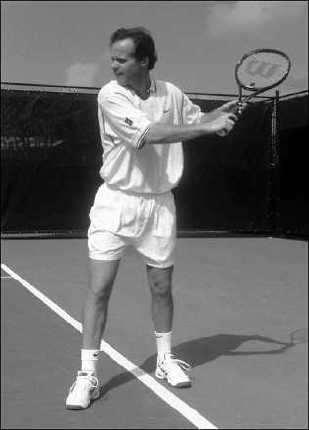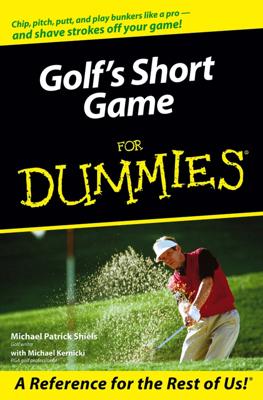Slice, or backspin, causes the tennis ball to spin back toward the source of impact (you). When a slice shot bounces, the ball stays low, forcing your opponent to really stretch to get to the ball. If players like to attack the net and volley, they slice a lot.
The slice can be a useful weapon, but it does have some disadvantages. Slice shots never travel with a lot of pace. Slice shots that are hit from lack of confidence or in a desperate attempt to just get the ball back tend to float, and they travel through the air slowly. Your opponent can do almost anything he wants with them, especially from a position up at the net.
Mastering the forehand slice
Slice always imparts control. Like all slice shots, the forehand version is hit high-to-low, with the strings brushing under the ball. Just before you start your forward swing, raise the racquet head to shoulder height, open the face so that the hitting surface faces up, and produce slice by cutting under the ball with a long, smooth stroke.
The slice forehand is easy to master, and a fair number of hackers resort to it. But don't use it as a substitute for your flat or topspin forehand. It's a defensive shot that you should use on only three occasions:
- When you're scrambling to retrieve a good, angled shot by your opponent (this is called making a get) and can't set up to hit a conventional forehand — you can swipe the ball back with slice and buy yourself a little time to get back into position.
- When you're moving forward toward the net and you want to drive a low-bouncing ball into the corner of your opponent's court.
- When you want to surprise your opponent with a drop shot.
Dressing up your backhand with slice
If you have trouble effectively hitting the flat backhand, you can use a slightly different stroke that carries many players far in the game — the pure slice backhand. Many pros, including the legendary Australian champion Ken Rosewall, used the slice backhand stroke as their only backhand. The slice backhand suited their approach to the game, which was based on control rather than power.
The slice backhand offers the following practical and tactical advantages:
- The slice stroke is simple. You hit under the ball, instead of through and over it, as you do on the flat backhand. That's just plain easier.
- Slice slows the ball down. A ball hit with any kind of spin travels slower than a flat one. Slice shots don't bounce as high, either. Those two qualities can catch your opponent off guard and screw up her timing.
- Slice shots travel in a flat trajectory. You don't have to lift the ball over the net in an arc and then get it to drop back down inside the boundaries of the court like you do with your other shots.
A word of caution: Slice backhands make poor passing shots. Slow pace and the flat trajectory give your opponent two big advantages: more time and an ideal height, at about a foot above the net, to smash away a winner.
Basically, you hit the slice backhand just as you would hit your standard backhand (both one-handed and two-handed backhands), changing only the following things about your stroke:
1. As the ball approaches and you rotate your shoulders to your left, bring your racquet back above your left shoulder.
Your stance resembles the stance you take when you step up to the plate and get ready to swing a baseball bat — in both cases, your hands are up around your left shoulder. The major difference is that the racquet shouldn't be pointing straight up, at a 90-degree angle, like a bat. The racquet head instead should be pointing at the back fence, at about a 45-degree angle.
When your backswing is complete, your right shoulder is close to your chin, and your right elbow points in the same direction as your right foot.
2. Turn the racquet face as you bring it back so that the hitting surface ends up facing upward, as shown in Figure 1.
This position makes it easy and natural to brush your strings under the lower portion of the ball, producing backspin.
 |
Figure 1: Hold your racquet at a 45-degree angle to the fence when you slice your backhand. |
3. Swing forward with a high-to-low motion.
Release the racquet with your left hand as you do this. On slice shots, the racquet doesn't come around and up, making an arc. It moves forward and down, coming around to your right side only at the tail end of your stroke, long after the ball is gone.
Make contact with the ball, with the racquet "slicing" under it, when it's at a point about even with your right shoulder.
High bouncing balls are ideal for hitting slice shots, but you can play balls at any height with a slice by bending more at the knees and/or adjusting the height of your back and forward swings. Think of your racquet face as an elevator that you need to move to the right "story" or height to pick up the passenger, a bright yellow tennis ball!
4. Follow through until your racquet arm is fully extended, with the head pointing toward the ground at a moderate angle.
If you hit this shot from a comfortable, set position (at about the center of the baseline), your racquet should be pointing toward the right netpost.

